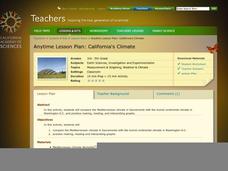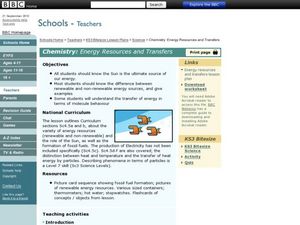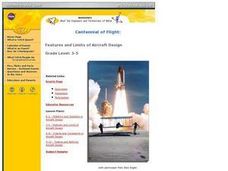Computer Science Unplugged
Lightest and Heaviest—Sorting Algorithms
How do computers sort data lists? Using eight unknown weights and a balance scale, groups determine the order of the weights from lightest to heaviest. A second worksheet provides the groups with other methods to order the weights. The...
California Academy of Science
California's Climate
The United States is a large country with many different climates. Graph and analyze temperature and rainfall data for Sacramento and Washington DC as you teach your class about the characteristics of Mediterranean climates. Discuss the...
DiscoverE
Textbook Support Challenge
Textbooks are heavier than a sheet of paper, so how can paper hold up a textbook? Young engineers create a structure out of paper that can support a textbook. To add another wrinkle, they must stay within budget and time constraints.
Curated OER
Thinking Like a Scientist
Students explore the scientific method. Students identify the steps in the scientific method and explain what each step means. Students use these steps to determine if boys or girls are taller in their classroom.
Curated OER
Pollination
Third graders discuss pollination and how bees pollinate flowers. In this pollination lesson plan, 3rd graders draw the pollination process on a piece of paper.
Curated OER
Chemistry: Energy Resources and Transfers
Learners explore the concepts of energy resources and energy transfers. In this chemistry lesson, students examine renewable and non-renewable energy sources as they view classroom demonstrations and discuss the concepts as well as their...
Curated OER
Physics: Electricity and Magnetism
Pupils draw series and parallel electrical circuits. In this electromagnet lesson, students describe how current changes depend on circuit components. Pupils use an OHT of a series and parallel circuit to predict the path of...
Curated OER
Creative Problem Solving
Students respond to a situation presented about the wetlands. For this wetlands lesson, students understand the various opinions over the use of areas in the wetlands. Students complete a worksheet using critical thinking questions about...
Curated OER
Make Something Beautiful
Students create an art piece using recycled objects. In this environmental activity, students collect and sort recycled objects and create a three dimensional art piece.
Curated OER
Features and Limits of Aircraft Design
Students identify the desired features of an aircraft and the limits that they, the Wright Brothers, or NASA scientists might face in designing one, and methods to solve these. They review parts of an airplane and what makes it fly. They...
Curated OER
"And The Wind Blows..."
Students investigate a scenario involving the efficient use of wind power. They are challenged to ten grams of cargo a specified distance using only wind power.
Curated OER
Our Inventions
Students construct or draw an invention of their own design. In this problem solving lesson, students define the word invention, discuss famous inventions, invetors, and how inventions come about. Students work in groups to...
Curated OER
Diversity/Journalism - Book Making
Third graders explore Canadian culture by creating a book. In this community analysis lesson, 3rd graders identify the First Nations people of Canada and discuss the culture, language and diversity. Students create a book discussing...
Curated OER
Ball-Launcher Design
Third graders use a simple design process to solve the problem of launching a ping pong ball the farthest distance. They discuss the design process, and in small groups, design, build, and test a launching device that adheres a variety...
Curated OER
Air Is All Around Us!
Students design an instrument to show that air is all around. In this air lesson plan, students research, construct, and present a design that proves that air is all around, even though they can't see it or touch it. A teacher and self...
Curated OER
Elements for Disaster Reporting
Students identify the elements of natural disasters and gain an understanding on how the media influences people's responses to disasters. In this natural disaster lesson plan, students study the impact of natural disasters, and the...
Curated OER
Extreme Weather
Students examine different types of extreme weather and how to prepare for them. In this weather lesson students explore different types of extreme weather and create disaster preparation posters for different types of extreme weather.
Curated OER
Down with Dairy and the Food Pyramid
Learners discuss food pyramid, name parts of pyramid, discuss dairy products and how they are beneficial to people, and participate in dairy taste testing.
Curated OER
Is That Natural?
Students examine how they use and waste natural resources. They participate in a class discussion about natural resources, in small groups complete a worksheet identifying ways students misuse natural resources, and create an...
Curated OER
Lighten Up!
Third graders observe light as a form of energy, that it can be reflected/bounced, refracted/bent and absorbed. They explore how different types of light affect our lives as a whole. Songs are researched that involve light (ex. "You...
Curated OER
The Tropical Rain Forest
Students use various web sites to access information about the rain forest. They use the Tropical Rainforest Interactive CD to make their own rain forest pictures and stories and learn facts about the rain forest. They use various books...
Curated OER
Jungle Gym Drop
Students investigate gravity, force and motion. In this motion of objects lesson, students drop various objects from a jungle gym and collect, measure and observe their data. Students describe the forces that affect the motion of their...
Curated OER
The Froggy Page
Students investigate the cycle of life by observing tadpoles. In this biology instructional activity, students utilize the Internet to read stories, observe pictures, and listen to sounds of frogs. Students create a poster...
Curated OER
Gone But Not Forgotten
Third graders examine animals and organisms that have become extinct and their similarities to living organisms. In this extinction instructional activity students divide into groups and research extinct animals.























